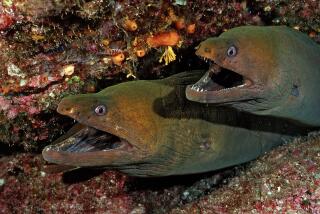Giant oarfish carcass found off Catalina to be split for research
A rare 18-foot oarfish that was found dead off Catalina Island has been dissected and will be split between several universities for research.
The serpent-like fish, among the largest reported in nearly 20 years, was spotted by a snorkeler in about 20 feet of water on Oct. 13, said Jeff Chace, program director at Catalina Island Marine Institute.
A second oarfish, measured at 14 feet, washed ashore in Oceanside on Friday and is being examined by scientists.
Pieces of the massive fish found off Catalina will be split between research institutions including UC Santa Barbara, Penn State and the Natural History Museum of Los Angeles County, he said.
“Not a ton is known about it, so we wanted to give people access,” Chace said, who described the fish’s eye as being the size of a tennis ball.
The rare, ribbon-shaped sea creature is believed to be the world’s largest bony fish and lives mostly at great depths. Because of its size and menacing appearance, bearing more resemblance to the Loch Ness Monster than a fish, the oarfish may be the source of tales of sea serpents.
The fish largely remain mysterious to scientists but are typically found 700 to 3,000 feet beneath the surface in tropical waters.
Original plans for the Catalina Island oarfish included burying the huge carcass, which was too large for staff members at the institute to refrigerate. But experts at the Natural History Museum said the bones are so fine they would be crushed by the weight of the sand, Chace said.
The institute, which educates about 40,000 children a year, hopes to keep the skeleton on display, he said.
“One of the neat things for kids is the unknown factor,” he said. “These discoveries are happening all the time, and it gets kids excited about science.”
Rick Feeney, ichthyology collections manager at the Natural History Museum of Los Angeles County, told The Times last week the creatures only “wash up occasionally” because they’re typically in deep open ocean.
When oarfish come closer to shore, Feeney said it may be a sign of distress. They could be starving, disoriented or landed in shallower water because of a storm.
“They’re usually in the deep ocean, away from land,” Feeney said.
A 12-foot oarfish washed ashore in Malibu in 2010, but it was a much smaller variety.
In recent years, researchers have captured video of an oarfish swimming deep underwater in the Gulf of Mexico and spotted one swimming not far from the shore in Baja California. But not since a group of U.S. Navy SEALS found a 23-foot-long oarfish off Coronado in 1996 has such a large oarfish been reported.
ALSO:
Father responding to Craigslist ad fatally shot in front of son
Patient at Northern California hospital shot dead by sheriff’s deputy
Drug-dealing charges to be filed against husband of Montebello mayor
Twitter: @Sam_Schaefer
More to Read
Sign up for Essential California
The most important California stories and recommendations in your inbox every morning.
You may occasionally receive promotional content from the Los Angeles Times.











